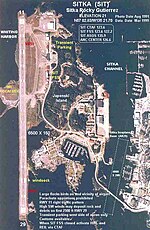Sitka Fine Arts Camp

Sitka Fine Arts Camp is a nationally-recognized fine arts summer camp located in Sitka, Alaska. The camp was established in 1973 at Sheldon Jackson College. It used other locations in the years that followed before acquiring the majority of historic Sheldon Jackson College buildings and campus in 2011. It took almost four years for a USDA Rural Development loan to be transferred from the college to the camp because of a "maze of paperwork," but it was done in 2013. The college was established in 1878 and was the oldest institution of higher learning in Alaska. The camp enrolled approximately 700 in 2013 and offerings have expanded to include a circus program. Adult programs such as a Native Jazz Workshop and the Sitka Arts and Science Institute are also offered and have included artists such as Jason Marsalis.
Excerpt from the Wikipedia article Sitka Fine Arts Camp (License: CC BY-SA 3.0, Authors, Images).Sitka Fine Arts Camp
Tongass Drive, Sitka
Geographical coordinates (GPS) Address Nearby Places Show on map
Geographical coordinates (GPS)
| Latitude | Longitude |
|---|---|
| N 57.0519 ° | E -135.3517 ° |
Address
Tongass Drive
99835 Sitka
Alaska, United States
Open on Google Maps






